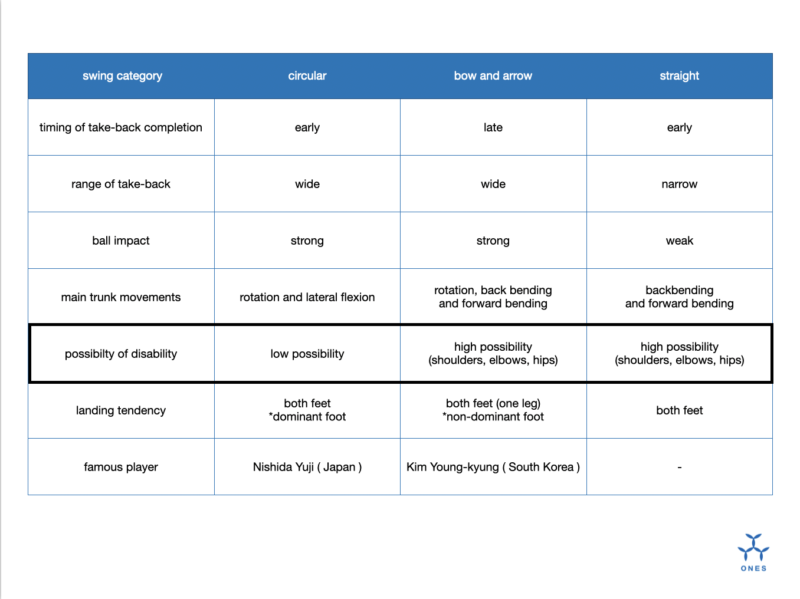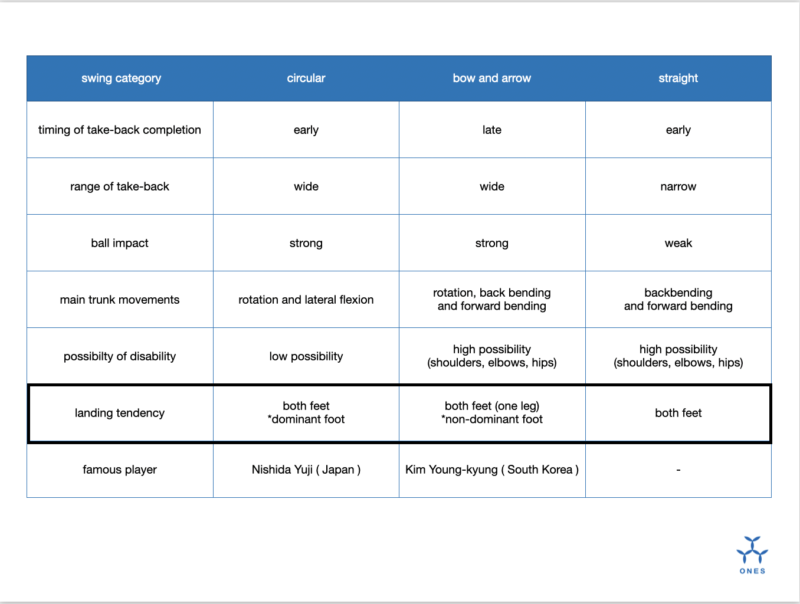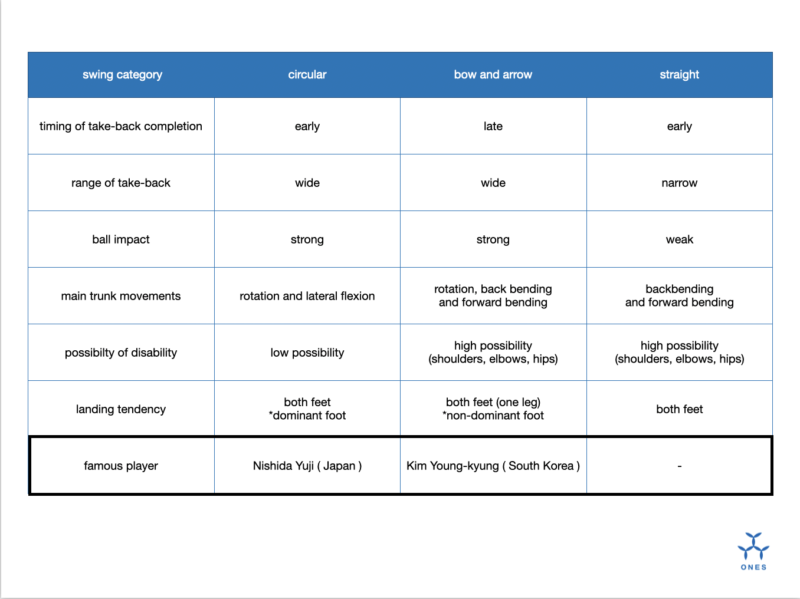This article will continue with a discussion of each spike swing action, with a comparison table.
Possibility of disability

Although it is sort of inevitable that certain movements repeated over and over again will one day cause disorders, it is feasible to reduce the likelihood of disorders by acquiring rational movements that are less physically demanding.
In particular, the spike swing movement is used a lot when playing volleyball, so it must be said that how to acquire a rational swing can have a significant impact on a player’s life.
The most important aspect to focus on when thinking about rational movement is, as mentioned earlier, trunk movement. The rotation movement has a low moment of inertia (the amount of force required for an object to move in a rotational motion), which means that it can generate a lot of power with little energy consumption. In other words, it is a rational movement. In contrast, forward and backward bending movements have a large moment of inertia (the amount of force required for an object to move in rotational motion) and therefore require a large amount of energy to generate power. In other words, it is an irrational movement and places a great load on the body as it is repeated over and over again. They cause disability.
*Lateral bending movements are the main trunk movement, but with regard to the spike swing movement, they are considered to be relatively auxiliary and incidental movements.
In this light, it becomes obvious what is the swing that is least likely to cause impairment. They are as follows.
Circular (possibility of disability : low possibility)
Circulars are clearly less likely to be disabling. Rotation and lateral flexion are the main trunk movements, with anterior-posterior flexion movements being less likely to occur.
Bow and arrow (possibility of disability : high possibility *shoulder, elbow and hip)
The bow and arrow is similar to the circular in that the main trunk movement is rotation, but as mentioned above, there is a tendency for the bow and arrow to add a strong back and forth bending movement when the ball is caught behind the zero position during the take-back movement, or when the player tries to hit hard when sufficient rotation is not achieved. This can lead to back and shoulder problems.
Straight (possibility of disability : high possibility *shoulder, elbow and hip)
The straight swing is, in conclusion, the most likely to cause injury. The main body movement is forward and backward bending, and the take-back is small, which inevitably results in stress on the hips, shoulders, elbows and all other parts of the body. It is also very difficult to generate a lot of power.
Landing tendency

Let’s take a closer look at landing tendencies. The reason why we have added the aspect of landing tendency is that a good or bad landing can cause serious life-threatening injuries and chronic disability. Landing after a jump is said to be approximately three to five times more demanding than the athlete’s own body weight, although this varies greatly depending on the athlete’s weight and jumping ability.
Circular (landing tendency: both feet * dominant foot)
Circulars have a tendency to land on both feet, dominant foot dominant. The pre-hit turning and lateral bending movements move the non-dominant hand towards a forward and higher hit position. Then, from there, towards the ball hit, the dominant hand moves towards the front and higher hit position of the body by the opposite trunk movement (left rotation and left lateral flexion movement). After the ball is hit, the twisting motion of the trunk continues and the dominant foot, like the dominant hand, moves towards the front of the body and both feet land at approximately the same time, sometimes with a slight dominance of the dominant foot.
Bow and arrow (landing tendency: both feet (one leg) * non-dominant foot dominant)
Bow-and-arrows tend to land on both feet, non-dominant foot dominant. The non-dominant hand moves towards the hit position by means of a pre-hit turning and backbending movement. However, unlike the Circular, backbending movements are more likely to occur than lateral bending movements, so the hit position defined by the non-dominant hand tends to be slightly backwards (covered). The reverse trunk movement (left rotation and forward bending) then takes place, but the ball-hit position tends to be relatively covered compared to the circular. This inhibits the reverse trunk twisting action and the turning motion stops in the middle. This leads to a landing without the dominant foot moving forwards as well as the dominant hand, with both feet landing at approximately the same time, or in some cases with non-dominant (one-footed) feet.
Straight (landing tendency: both feet)
The straight arm is a two-footed landing. As explained so far, there is almost no rotation or lateral bending movement, so twisting of the trunk is unlikely to occur. For this reason, landing on both feet is the basic landing technique.
Famous player

Circular (famous player: Nishida Yuji *Japan)
Nishida’s swing trajectory is very distinctive compared to other players. He is a very small male player by world standards. He may well find that he is a circler, especially during back row attacks where he has a broad jump, ensuring a sufficient approach.
Bow and arrow (famous player: Young Kyung Kim *South Korea)
A player who has been playing at the world’s top level for a long time. By world standards, she is one of the tallest female players. Her approach length is relatively short compared to other players, her jump is straight up and her hit point could be described as rather backward.
Straight (famous players: non)
It is probably difficult to find a famous player with this swing. If there are any such players, we would be very interested to hear about them.




